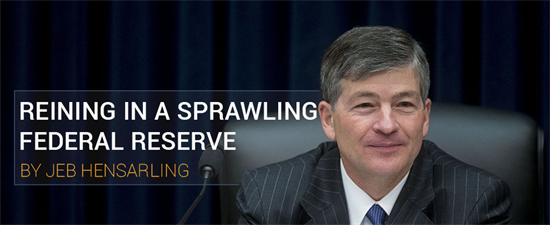ICYMI: Reining In a Sprawling Federal ReserveBy Jeb Hensarling
Washington,
November 20, 2015
Since the 2008 financial crisis, the Federal Reserve has morphed into a government institution whose unconventional activities and vastly expanded powers would scarcely be recognized by drafters of the original legislation that created it. Regrettably, commensurate transparency and accountability have not followed. Since September 2008, the Fed’s balance sheet has ballooned to $4.5 trillion, equal to one-fourth of the U.S. economy and nearly five times its precrisis level. And after seven years of near-zero interest rates, the central bank’s so-called forward guidance provides almost no guidance to investors on when rates might be normalized. This uncertainty is a significant cause of businesses’ hoarding cash and postponing capital investments, and of community banks’ conserving capital and reducing lending. Adding to the economic uncertainty, the 2010 Dodd-Frank law granted the Fed sweeping new regulatory powers to intervene directly in the operations of large financial institutions. The Fed now stands at the center of Dodd-Frank’s codification of “too big to fail.” With respect to these firms, the Fed is authorized to impose “heightened prudential standards,” including capital and liquidity requirements, risk management requirements, resolution planning, credit-exposure report requirements, and concentration limits. The Fed is even authorized, upon a vague finding that a financial institution poses a “grave threat” to financial stability, to dismantle the firm. The Fed, in short, can literally occupy the boardrooms of the largest financial institutions in America and influence how they deploy capital. The Fed’s monetary policy must be made clear and credible, and its regulatory activities must comport with the rule of law and be subject to public scrutiny. To accomplish this, the Fed Oversight Reform and Modernization Act of 2015, sponsored by Rep. Bill Huizenga (R., Mich.), should be enacted. Here are the main parts of the FORM Act, which was passed by the House of Representatives on Thursday. In regard to monetary policy, the Fed must publish and explain with specificity the strategy it is following. The Fed retains unfettered discretion to choose the rule or method for conducting monetary policy. The FORM Actsimply requires the Fed to report and explain its rule, and if it deviates from its chosen rule, why. Economic history shows that when the Fed employs a more predictable method or rules-based monetary policy, more positive economic outcomes result. Some say this would compromise the Fed’s independence. It would not. The FORM Act merely affects how and when the exercise of its discretionary monetary policy is communicated to the public. To the extent there is a threat to the Fed’s independence, it emanates from the executive branch. There is a revolving door between the Fed and the Treasury. The Fed chair meets weekly with the Treasury secretary in private, yet is compelled to testify in public before Congress only twice a year. Thanks to members’ leaving office early in their 14-year terms, President Obama has been able to appoint all of today’s Fed governors. The FORM Act also would compel the Fed to conduct cost-benefit analysis for all regulations it promulgates. Dodd-Frank directed the Fed to publish upward of 60 new regulations, some in conjunction with other agencies. But it did not require the bank to conduct cost-benefit analyses, which other regulatory bodies, such as the Securities and Exchange Commission and the Commodity Futures Trading Commission, must. The Fed’s failure to carry out cost-benefit analyses has resulted in excessive regulatory burdens—most notably on small banks and businesses—which have harmed the U.S. economy and slowed recovery. Requiring cost-benefit analyses also means Fed regulations would be subject to judicial review, in other words, subject to the unbiased and independent scrutiny that is integral to due process and the rule of law. The Fed’s authority under Dodd-Frank to stress test the operations of financial institutions it deems “systemically important” allows regulators to essentially dictate the business models and operational objectives of large financial institutions. Yet this process is far from transparent, making it difficult for Congress and the public to assess either the effectiveness of the Fed’s regulatory oversight or the integrity of its findings. The FORM Act will remedy this by providing for public notice and comment on the Fed’s stress-test scenarios and by requiring the Fed to also disclose a summary of the stress-test results that financial institutions have to resubmit if they fail the initial stress test. Finally, the FORM Act places needed constraints on the Fed’s emergency lending powers. Dodd-Frank tried but failed to rein in the Fed’s emergency lending authority. The FORM Act restricts emergency loans to financial institutions only, increases the interest charged on emergency loans, and requires not only a supermajority of Federal Reserve governors but also a supermajority of district bank presidents to approve emergency loans. With these reforms, the FORM Act discourages moral hazard-inducing bailouts of “too big to fail” firms that enrage hardworking taxpayers. The greater the powers ceded to the Fed, the more its activities must be opened up to scrutiny and critical examination. Otherwise, we may soon awake to discover that our central bankers have instead become our central planners. ### |


